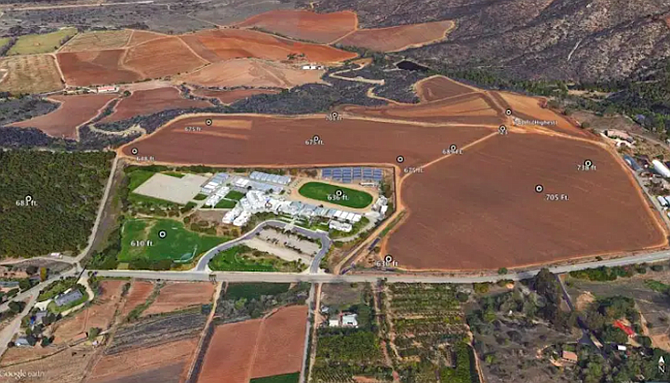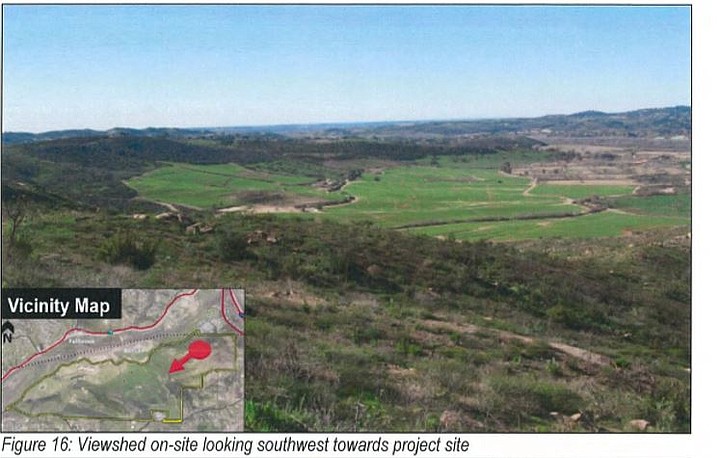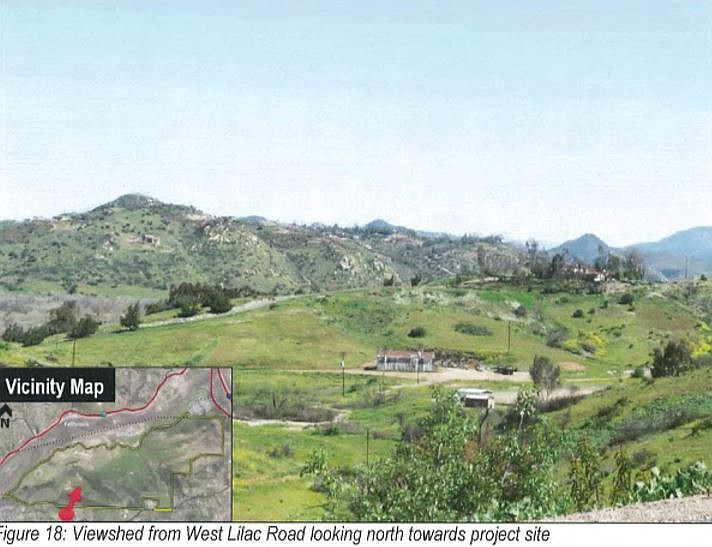 Facebook
Facebook
 X
X
 Instagram
Instagram
 TikTok
TikTok
 Youtube
Youtube

At a glance, Ocean Breeze Ranch looks like sprawl. The sort of rural project that inspired an initiative on the March ballot to let voters decide if it belongs there. Measure A would apply to any housing proposal with six units more than currently allowed by zoning.
Ocean Breeze would build 396 new homes in pastoral Bonsall on a 1,403-acre property, which sounds like all those other housing plans that would build hundreds of homes miles from job centers, smack in fire country.
But supporters say this one is different. When it comes to growth in the unincorporated area, where capacity is projected to be more than 232,300 existing and future homes through 2050, not all plans are equal. An appeal by a citizen's group was countered by the Endangered Habitat League, which called the project "exemplary." The site, located west of Interstate 15 in the San Luis Rey River Valley, is within a draft pre-approved mitigation area (having high biological value) for the North County habitat plan. "It puts in place a segment of the North County Multiple Species Conservation Plan," says Dan Silver, executive director of the Endangered Habitat League. "Best planning to emerge from the county in a long time."

In recent years, supervisors approved a batch of rural projects that would require general plan amendments to fit them in where they don't fit. A fight ensued, with environmental groups joining forces, filing lawsuits to challenge the approvals. Building in the backcountry came down to a simple question: should the general plan be followed, rather than amended, when developers eye the unincorporated county? Ocean Breeze didn't require an amendment to the general plan, "unlike Newland, Lilac, Harmony Grove Village South, and Valiano," Silver says.
Another reason the League supports it is that it doesn't increase density. Instead, it relies on density transfer, reshuffling the number of homes per acre to create a more compact footprint. The general plan permits such changes where there is more than one land use designation within a project. Ocean Breeze contains several, from semi-rural to rural. About two percent of the unincorporated county is designated as village, 10 percent as semi-rural, and 37 percent as rural lands. "While the Endangered Habitat League would prefer more urban development, this project had some village designations," Silver says.

Also, projects that contain semi-rural residential and rural land use designations are required to design a project as a conservation subdivision, which squeezes it down by reducing lot sizes. Lots will range from 4,500 to 5,000 square feet in two planning areas, and five-acre minimum lots to approximately 24 acres in another area. "It was a major challenge to accommodate both general plan density and properly configured biological open space," Silver said in a letter to supervisors.
Ocean Breeze Ranch, LLC, has been honing its application since 2016. The proposal keeps intact an existing private horse facility, adds seven private and public parks (15.7 acres), approximately five miles of trails, four miles of sidewalks, roads and landscaping, and preserves more than half the site as permanent biological open space.
In December, the planning commission approved the tentative map, two major-use permits, and a site plan. They also found the project consistent with the environmental impact report certified in 2011 for the general plan update. Not everyone who attended a public hearing agreed. There were concerns about traffic, road improvements, fire evacuation, and more.

After hearing public testimony, the commission added a condition that the applicant will provide a $250,000 contribution to the Bonsall Unified School District for a parking lot. A group called Save Lilac later appealed the project, saying it doesn't comply with the environmental impact report prepared for the county's general plan, should not have used an exemption to comply with the California Environmental Quality Act, and is inconsistent with the general plan and the Bonsall Community Plan.
The appeal was withdrawn the day before a hearing on February 12. But another opponent, Jack Shue of the Cleveland National Forest Foundation, spoke out — and not because the general plan had been dodged again. The problem was the general plan itself. It allowed the project to avoid further environmental review since it was consistent with the general plan. "I want to point out that we think this is an error. Because the general plan isn't perfect. A lot of things have changed since we've done that plan," Shue said. "We have much more threat of wildfires, climate change is a major threat to the world and our communities here." Silver says the project used California Environmental Quality Act guidelines, and the approach was typical of most general plan consistent projects. It may not be perfect, but "it is way better than what would have happened otherwise. We were not starting from a blank canvas. You have to deal with the existing zoning, even if not ideal."


At a glance, Ocean Breeze Ranch looks like sprawl. The sort of rural project that inspired an initiative on the March ballot to let voters decide if it belongs there. Measure A would apply to any housing proposal with six units more than currently allowed by zoning.
Ocean Breeze would build 396 new homes in pastoral Bonsall on a 1,403-acre property, which sounds like all those other housing plans that would build hundreds of homes miles from job centers, smack in fire country.
But supporters say this one is different. When it comes to growth in the unincorporated area, where capacity is projected to be more than 232,300 existing and future homes through 2050, not all plans are equal. An appeal by a citizen's group was countered by the Endangered Habitat League, which called the project "exemplary." The site, located west of Interstate 15 in the San Luis Rey River Valley, is within a draft pre-approved mitigation area (having high biological value) for the North County habitat plan. "It puts in place a segment of the North County Multiple Species Conservation Plan," says Dan Silver, executive director of the Endangered Habitat League. "Best planning to emerge from the county in a long time."

In recent years, supervisors approved a batch of rural projects that would require general plan amendments to fit them in where they don't fit. A fight ensued, with environmental groups joining forces, filing lawsuits to challenge the approvals. Building in the backcountry came down to a simple question: should the general plan be followed, rather than amended, when developers eye the unincorporated county? Ocean Breeze didn't require an amendment to the general plan, "unlike Newland, Lilac, Harmony Grove Village South, and Valiano," Silver says.
Another reason the League supports it is that it doesn't increase density. Instead, it relies on density transfer, reshuffling the number of homes per acre to create a more compact footprint. The general plan permits such changes where there is more than one land use designation within a project. Ocean Breeze contains several, from semi-rural to rural. About two percent of the unincorporated county is designated as village, 10 percent as semi-rural, and 37 percent as rural lands. "While the Endangered Habitat League would prefer more urban development, this project had some village designations," Silver says.

Also, projects that contain semi-rural residential and rural land use designations are required to design a project as a conservation subdivision, which squeezes it down by reducing lot sizes. Lots will range from 4,500 to 5,000 square feet in two planning areas, and five-acre minimum lots to approximately 24 acres in another area. "It was a major challenge to accommodate both general plan density and properly configured biological open space," Silver said in a letter to supervisors.
Ocean Breeze Ranch, LLC, has been honing its application since 2016. The proposal keeps intact an existing private horse facility, adds seven private and public parks (15.7 acres), approximately five miles of trails, four miles of sidewalks, roads and landscaping, and preserves more than half the site as permanent biological open space.
In December, the planning commission approved the tentative map, two major-use permits, and a site plan. They also found the project consistent with the environmental impact report certified in 2011 for the general plan update. Not everyone who attended a public hearing agreed. There were concerns about traffic, road improvements, fire evacuation, and more.

After hearing public testimony, the commission added a condition that the applicant will provide a $250,000 contribution to the Bonsall Unified School District for a parking lot. A group called Save Lilac later appealed the project, saying it doesn't comply with the environmental impact report prepared for the county's general plan, should not have used an exemption to comply with the California Environmental Quality Act, and is inconsistent with the general plan and the Bonsall Community Plan.
The appeal was withdrawn the day before a hearing on February 12. But another opponent, Jack Shue of the Cleveland National Forest Foundation, spoke out — and not because the general plan had been dodged again. The problem was the general plan itself. It allowed the project to avoid further environmental review since it was consistent with the general plan. "I want to point out that we think this is an error. Because the general plan isn't perfect. A lot of things have changed since we've done that plan," Shue said. "We have much more threat of wildfires, climate change is a major threat to the world and our communities here." Silver says the project used California Environmental Quality Act guidelines, and the approach was typical of most general plan consistent projects. It may not be perfect, but "it is way better than what would have happened otherwise. We were not starting from a blank canvas. You have to deal with the existing zoning, even if not ideal."
Comments